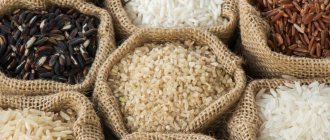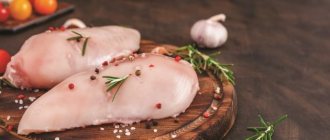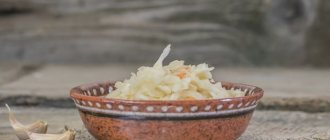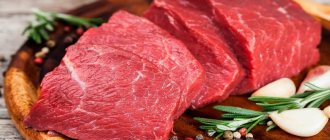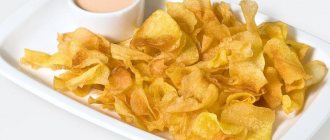What does turkey meat contain?
The calorie content of 100 grams of product is 189 kcal . The same amount of turkey meat has the following nutritional values:
- water (63.52 g);
- carbohydrates (0.06 g);
- fats (7.39 g);
- easily digestible protein (28.55 g);
- ash (18 g).
This protein content allows us to talk about turkey meat as the most suitable for dietary and baby food .
The legs (11 g of fat per 100 g of product) and poultry skin are considered to be the most nutritious and contain the most fat. Cholesterol and other substances that are not very useful for the body are deposited in them. Breast has the least amount of calories - it contains 0.84 g of fat per 100 g of product. A complete protein provides a person with the necessary set of fat-soluble vitamins and a set of amino acids better than cheese.
The rich vitamin composition is presented:
- fat-soluble vitamins A, D, E;
- water-soluble vitamins B1, B2, B3 (PP), B4, B5, B6, B9 and B12.
We recommend reading about the composition, benefits and preparation of duck, goose, guinea fowl, rabbit, and lamb meat.
These vitamins have a great positive effect on the human body :
- In the body, vitamin A plays a role related to the processes of reproduction and growth, support of immunity, vision function and restoration of epithelial tissues.
- Calciferol (vitamin D) has antirachitic properties. Calciferols participate in calcium metabolism in the body: they promote the absorption of calcium from the digestive tract and its accumulation in bone tissue.
- Vitamin E is a natural antioxidant, participates in the biosynthesis of proteins and the most important processes of cellular metabolism.
- B vitamins are involved in all basic processes of the body: they influence metabolism and participate in neuro-reflex regulation.
In addition to proteins, fats, carbohydrates and vitamins, elements play a major role in the human body. To date, more than 70 different macro- and microelements have been found in the tissues of the body. Of these, about 36% are present in turkey.
Calorie content of different parts of the carcass
We have already mentioned that the calorie content of beef will change depending on the food. Let's give a few examples to make it easier for you to choose the part that is most suitable for the right dinner.
- The lowest calories will be heart, kidneys and tender fillet - from 77 to 95 kcal.
- Liver - 98.
- Brisket - 110-125.
- Shoulder flesh without fat layer - 195.
- Blade part - 208.
- Sirloin, rib part - 380.
- Brisket with fat layer - 405.
- The most calorie-rich ones will be the favorite ribs - 446.
The calorie content of meat per 100 grams varies from 120 to 500 kcal and depends on the variety, type and category. The way in which the product is prepared also plays an important role.
Taste qualities
The taste of the carcass is determined by what the bird was fed. Therefore, many people prefer to buy carcasses from farmers rather than in stores. Broth or soup with such meat is very aromatic, stimulates appetite, increases energy levels and invigorates.
The taste preferences of each person are individual, but turkey is considered to be a more delicious and tasty meat than chicken, beef or pork.
Roast beef
This type of meat preparation is not recommended for those losing weight and people who suffer from problems with the stomach or heart muscle. Fried in oil will only harm the figure and the body as a whole. Note that during frying, most of the beneficial substances that could have a beneficial effect on your body “disappear.”
How many calories are in A? Let’s not just name the number, but for comparison, remember the boiled version. In a correctly selected piece (that is, tender tenderloin, tongue or heart) of boiled meat there will be, as we have already said, 95 kilocalories per hundred grams. Now, attention! One hundred grams of roast beef contains 384 calories. Imagine the difference.
What are the benefits of turkey meat?
The set of macro- and microelements, as well as vitamins, creates a number of unique properties:
- accelerates intracellular processes and metabolism in the body;
- prevents the risk of anemia;
- has a positive effect on the functioning of the myocardium and circulatory system;
- normalizes blood pressure;
- replenishes the amount of calcium in the body and forms the skeletal system;
- protein, as a source of natural protein, helps in the development of muscle mass.
Turkey meat is included in dietary and therapeutic nutrition for those recovering from an illness . Positively affects the functioning of the stomach.
Turkey-based broth replenishes strength, saturates the body with useful substances, and strengthens the immune system. It is often used as a means of preventing and treating respiratory viral diseases, influenza, and sore throat. The most delicious and healthy broth is obtained if you add roots (carrots, celery) and herbs to it. After taking the broth, a person’s well-being significantly improves.
Did you know? The biological role of microelements in the life of the body began to be studied only in the first half of the 20th century. The first microelement whose deficiency in the body was noticed was iodine.
For adults
All substances that enter the body of an adult have regulatory, restorative or supporting functions. The number of functions is determined by the set of macro- and microelements and their interaction with each other. Turkey meat saturates the body with energy, gives a boost of vigor and ensures a good psycho-emotional state. Regular consumption of it strengthens the immune system, protects the body from the influence of stress factors, and ensures good quality sleep.
Calcium and phosphorus strengthen the bone apparatus, prevent the development of stagnant processes in bone tissue and other pathologies. Selenium present in meat maintains the balance of hormones and improves the functioning of the body's endocrine system. It has a positive effect on the functioning of the cardiovascular system, removes cholesterol plaques, and prevents atherosclerosis and other vascular diseases. Turkey can be eaten by diabetics due to its low glycemic index.
Potassium is necessary to ensure intracellular processes. Potassium compounds help remove excess fluid from the body. Potassium metabolism disorders lead to dystrophy, kidney and cardiovascular diseases. Sodium is also necessary for intracellular metabolism. It affects the state of short-term memory, the muscular system and intestinal activity.
Important! Children (up to 1.4 g per day), pregnant women (up to 1.5 g per day) and nursing mothers (up to 1.8 g per day) need increased amounts of calcium.
For children
Turkey is a very healthy product for children because it is hypoallergenic and has high nutritional value for a growing body. The benefit lies in the supply of protein, which will be used by the body for the development of the muscular system and potassium to strengthen the skeleton and prevent diseases of the musculoskeletal system. Turkey can be introduced into the diet from 8 months of age as the first meat supplement. Turkey is included in baby food at least 2 times a week.
When feeding babies, you can use vegetables such as broccoli, cauliflower and Brussels sprouts, pumpkin, zucchini, and potatoes.
The benefit for children also lies in its ability to strengthen the immune system and promote body growth. The protein found in meat is ideal for gaining muscle mass . With a lack of protein, the body feels sluggish and chronic fatigue syndrome appears. Turkey helps prevent anemia, increase vigor and physical activity. Strengthening the skeleton with potassium and fluorine is also necessary for the child's body.
For athletes
For people with intense physical activity and athletes, turkey meat is a possible source of energy and protein recovery. Turkey contains about 30% easily digestible protein, a small amount of cholesterol, and an essential set of vitamins and minerals, which makes it the main type of meat in sports nutrition. Thanks to the content of various proteins, it allows you to quickly gain muscle mass. A rich vitamin and mineral complex makes turkey the best choice of meat on an athlete's menu.
Turkey provides:
- rapid recovery of the body after heavy physical activity;
- strengthening the skeleton;
- increasing endurance;
- burst of energy.
Important! Turkey can provide protein for athletes who cannot use the protein due to lactose intolerance (the protein is synthesized from it).
Disease Prevention
Regular (not necessarily daily - see “Harm” of turkey meat below) consumption can prevent:
- oncological pathologies;
- cold;
- neuroses;
- muscle dystrophy;
- caries;
- decreased immunity;
- cognitive disorders;
- cholesterol surges;
- the appearance of excess weight;
- lack of stamina;
- rapid muscle and emotional fatigue;
- pancreatic dysfunction;
- other.
All of the above applies to the breast muscle of the turkey, but cannot in any way be applied to its other parts.
Is it possible to eat
The main advantages of meat are low calorie content and high nutritional value. Hypoallergenic dietary meat can be eaten by all categories of adults and children, including athletes, those losing weight, and women during pregnancy and lactation.
During pregnancy and lactation
Useful for the diet of pregnant women primarily as a source of iron and protein . Turkey has a beneficial effect on the functioning of the gastrointestinal tract, normalizes digestive processes, stabilizes metabolism, and speeds up metabolism. A set of B vitamins in 100 grams of product is 60% of the daily requirement of vitamins of this group for a pregnant woman.
The folic acid
contained in it ensures the correct formation of the fetal nervous system, and also has a beneficial effect on the psycho-emotional state of the woman herself. The recommended amount in a pregnant woman's diet is 100-150 grams per day.
As a source of magnesium, it supports not only the nervous system, but also the functioning of the genitourinary system of a pregnant woman.
Important! Turkey is an ideal product for a woman during lactation. This is especially important in the first month of a baby's life. Cow's milk is excluded from the woman's diet during this period in order to avoid allergic reactions in the baby to its presence in the mother's diet.
When losing weight
A well-designed diet must include animal protein. Some amino acids the body needs are found only in meat and are not synthesized artificially. Turkey is a light type of meat and is therefore excellent for dietary nutrition.
When preparing food, you can easily control its calorie content :
- removed the skin - calorie content decreased by 1/3;
- If we used breast meat, the calorie content decreased even more.
At the same time, the food does not lose its taste. While low in calories, turkey is a source of healthy vitamins and minerals. The nicotinic acid contained in it controls the cholesterol level in the blood and promotes the breakdown of existing cholesterol plaques, and also prevents the formation of new ones. For those losing weight, it is important that this meat has no carbohydrates and very low fat content.
Turkey legs
When consuming “tasty” parts of a turkey carcass, you need to be aware that the skin, subcutaneous and intramuscular tissue fibers are fatty, and their composition cannot be considered a standard of dietary nutrition. Perhaps the most favorite dish has the following quality indicators:
- energy – 150 kcal;
- proteins – 16.0 g;
- fat – 9.0 g.
The indicators are logical if you evaluate the work and load on the muscles. The sternum works continuously, and therefore the muscle fibers contain the fewest calories.
The lower leg is in constant activity to maintain balance (even at rest). The turkey thigh only works when necessary to perform actions. Fat deposits accumulate in the tissues, which are needed as an energy reserve. It is necessary to eat them correctly or exclude them from the diet only under the supervision (on the recommendation) of a nutritionist.
Use in cooking
Meat is very popular not only because of its great benefits, but also because of its taste. The product can be prepared in various ways: frying, stewing, steaming, baking, boiling. It goes well with any side dish: vegetables, pasta or cereals. Its exceptional nutritional value allows it to be used in baby food and diets for those undergoing a period of rehabilitation after illness.
Can be used as an ingredient in meat salads, filling for pies, base for broth and in the form of sausages, sausages, cutlets , etc. Turkey served with white wine. Creamy sauces go well with it.
Did you know? Turkeys are the second largest poultry after ostriches. The weight of the male reaches 35 kg.
What they cook in different countries of the world
Every country has its own culinary traditions, including the preparation of turkey dishes.
Roast turkey is prepared for Christmas in many English-speaking countries. The British serve it at Christmas with a vegetable side dish. In the USA, they are stuffed with apples.
Turkey is the main dish of Thanksgiving. Also in America, this bird is the main decoration of the Thanksgiving table. Canadians serve poultry with cranberry sauce .
Find out the health benefits of cranberries and how to make cranberry sauce for poultry.
How long should you cook?
Before boiling the meat, it is cut into portions along the grain. After this, the product is doused with boiling water to preserve its juiciness during further cooking. During processing, the skin is removed.
Different parts of the carcass are not cooked equally:
- fillet – 30 minutes;
- legs – 60 min.
If the turkey is cut into large pieces, then they need to be cooked longer (about an hour). If during the cooking process you add 1 small carrot, 1 onion and spices to the water, the boiled meat will have a brighter and richer taste.
Boiling fillet for baby food has a number of features: after boiling the first broth for 10 minutes, drain it and continue cooking, pouring a new portion of water over the meat. This procedure will help get rid of excess fat and harmful substances.
Did you know? Geese are considered the most ancient domesticated bird. Turkey was domesticated by the Mayan Indians about 2 thousand years ago.
What goes with it?
In cooking, turkey can be combined with almost any product. The reason for this is its taste neutrality. When boiling meat, onions, carrots, garlic, peppers, bay leaves, and celery are often added to it.
For frying, a classic set of spices is used: onion, garlic, pepper. When baking, you can use (in addition to onions, garlic and pepper) coriander, paprika, cumin, ginger, cardamom, and anise.
Turkey meat is also combined with ingredients such as thyme, rosemary, marjoram, basil, oregano, cumin, dill, parsley, cherry tomatoes, red onions, leeks, sweet peppers, peas, honey, lemon.
Cooking secrets
Cooking different types of meat has its own secrets.
Marinating and baking:
- Time spent in the marinade is 2 days. After marinating, the turkey is washed so that marinade particles do not spoil the skin during baking.
- Before baking, the legs and wings are foiled to prevent burning.
- Start immediately before baking.
- In the oven, the turkey is cooked at a temperature of +180 degrees.
Boiling:
- Before boiling, you need to pour boiling water over the product (this will make it juicier).
- Boil the bird along with roots and spices - this will add taste and aroma.
Frying:
- Boiled pieces for salad are lightly fried.
- Fillet pieces are fried on all sides for 5-10 minutes. The legs are fried on each side for 15 minutes. To make the fillet juicier, after frying, you can simmer it for 10 minutes in a small amount of broth or marinade.
Characteristics
The homeland of turkeys is America, and the first turkeys were brought to Europe on the ships of the Spanish conquerors at the beginning of the 16th century. They liked the tasty and low-fat product, so they began to raise poultry at home. With skillful care, males reach 20 kg, and females - 15.
Fiber contains practically no cholesterol, but a sufficient amount of nutrients and vitamins. The rate of absorption of protein exceeds that of rabbit and chicken. Satisfaction comes with a smaller portion of food, so it began to be recommended in many diets.
In America and Western Europe, turkey meat has long enjoyed well-deserved popularity. It has firmly taken a central place in national cuisines or replaced fattier ingredients. Domestic consumers look at supermarket shelves with caution, not knowing where and how the product can be used.
In terms of taste, tender meat is between chicken and pork. It does not have the specific aroma of poultry, which is so annoying when consumed regularly. The minimum amount of fat is absorbed very quickly and does not leave extra centimeters on the waist and hips.
What does turkey meat look like? The breast is painted white, and the legs have a pleasant pink tint. The view in the photo shows a gradual transition from light parts to darker parts. The fillets are not as dry as chicken fillets. There is practically no fat layer under the skin.
How to store at home
The purchased carcass must be stored in the freezer.
There are a number of rules on how to handle meat:
- The brought carcass should be washed and wiped dry outside and inside, wrapped in foil and only then put in the freezer. If you are not going to cook the whole carcass, then before putting it in the freezer, it is better to cut it into portions, then pack it in foil and put it in the freezer.
- When meat is removed from the freezer, it should take at least 1 hour to defrost at room temperature. If you treat frozen fillet with hot steam or water, it will turn out tough when cooking.
- When defrosting a carcass using kitchen appliances, set the defrosting mode, not heating. This mode will better preserve the taste and vitamins B and C, which are destroyed when exposed to high temperatures.
Harm from eating poultry
Despite all the benefits of turkey, there are potential harms. There are cases of individual intolerance to the product. Even despite the absolute hypoallergenic nature of turkey meat. Therefore, such people should not eat this type of meat. Also, there are some restrictions on the consumption of Spanish chicken.
So, the product should be used with caution if you have the following diseases:
- Gout;
- Urolithiasis disease;
- Kidney or liver failure;
- Hypertension.
This is because large amounts of protein put excessive strain on the kidneys. Therefore, in the case of urological pathologies, the amount of protein food should be reduced. If you have hypertension, you should not completely stop using this product. But its level needs to be reduced. It is better to eat fillet, gudku, without skin.
